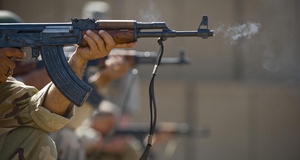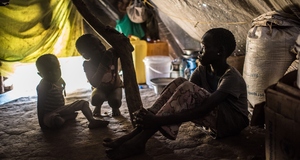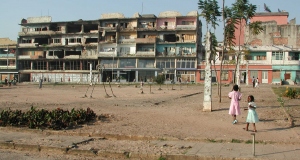From Cornell International Affairs Review VOL. 5 NO. 2Hot Cocoa: Agricultural Economics and the Ivorian Civil Wars
IN THIS ARTICLE
For roughly a decade, Côte d'Ivoire has been bitterly divided by a civil war between its dry Muslim north and its fertile Christian south. Many commentators have attempted to ascribe cultural or social origins to this war, casting it as an example of wider conflict between the Christian and Muslim worlds, while others see it as yet another example of the failings of weak, divided and tribalistic African states. I go beyond these narrow categories to explain the civil war as the natural outcome of a series of rational economic and political choices. The recent International Criminal Court arraignment of former president Laurent Gbagbo on charges of crimes against humanity marks the culmination of a decade of conflict in Côte d'Ivoire--, one of the most protracted periods of strife in West African history. Following the 1993 death of longtime leader Félix Houphouët-Boigny, or "Le Vieux," the country gradually descended into a largely broken state, divided by two civil wars. The conflict has caused Côte d'Ivoire, whose economic capital Abidjan was once called "the Paris of Africa", to lose its designation as one of Africa's most prosperous countries. Furthermore, the ensuing instability has resulted in the displacement of over a million people. Côte d'Ivoire‘s civil war is a complex process, with many disparate causes and ramifications. The main source of conflict has been a series of economic grievances that have fueled the country's political unrest. Economic incentives motivated the government to encourage a rapid expansion of the cocoa crop; however, these policies motivated farmers to harvest their crops beyond a sustainable limit, leading to lower and lower yields while attracting an unsustainable migrant inflow from the north. Faced with building ethnic tensions and the decreasing revenues from this fall in production, the government chose to adopt exclusionary policies towards outsiders thereby increasing ethnic inequality and fracturing the Ivorian national identity. Finally, northern rebels began to fight as ain response to this relative deprivation and the economic opportunity of their own cocoa, which acted as further fuel for the conflict. I first identify the structural conditions, both natural and political, that led to greater resentments and inequalities between the northern rebels and southern government. Then, I analyze the responses to these conditions, and discuss how the outcomes of these interventions increased resentment and inequality due to the perverse economic incentives of an authoritarian state. Finally, I show how elites mobilized their groups as a response to these grievances, using the country's deepening divide as a profit opportunity. All of these factors created a volatile political environment ripe for civil war. Côte d'Ivoire's civil war is a complex process, with many disparate causes and ramifications. The Economic "Miracle"In the twenty years following independence in 1960, Côte d'Ivoire was said to be experiencing an economic "miracle." Exports, especially cocoa, accounted for roughly 40 percent of gross domestic product (GDP) between 1960 and 1981--far more than what neighboring countries experienced. In addition, high commodity prices fueled growth rates as high as 12.3 percent in 1976.1 The government used this exceptionally high growth to extract rents from the cocoa sector to fuel industrialization, in a manner similar to other African countries. In 1977, these rents amounted to 16 percent of GDP, or roughly one billion dollars ( or $2.75 billion in today's money).2 The income from these rents not only helped Côte d'Ivoire advance economically much faster than its neighbors, it also consolidated the Houphouët-Boigny regime's hold on power by providing funds for its patronage mechanism.3 Since rents were dependent on the productivity of the agricultural sector, the Ivorian government promoted greater production at a lower cost by inviting cheap labor from abroad to work on cocoa holdings. Known as the Houphouët-Boigny "compromise," this policy guaranteed that land would "belong to those who make it produce," opening the possibility of land ownership for non-citizens.4 Drawn by the prospect of having their own fertile lands to work some day, hundreds of thousands of migrant workers streamed across the country's northern borders to take advantage of the opportunity and escape the drought that plagued their own countries.5 By 1981, almost all wage laborers on smallholder farms were immigrants.6 Over a million had come in from Upper Volta (present day Burkina Faso) and 500,000 had come to work from Mali.7 While this property rights regime succeeded handily in supplying adequate labor to the Ivorian cocoa industry, it had major unforeseen consequences that would reduce future rents and build the foundations for conflict. First, migrant workers who took advantage of the property ownership policy invested in their own smallholder farms when they had earned enough money to do so, often on the land of their former employer. Due to limits on space that could be cultivated, more producers meant a decrease in average production per holding. Increasing economies of scale meant that smaller cocoa farms would lead to a relative fall in total production, and thus a fall in rent potential.8 Second, the property rights regime encouraged unlimited expansion and exploitation of the land by treating it as an unlimited, cost-free resource.9 Although the policy encouraged higher output at its outset, the free-for-all mentality encouraged by the government hastened a decline in land productivity, a decline in production, and a decline in rent to extract. Falling rents exacerbated the need for greater production and migrant labor, deepening the downward spiral. The Houphouët-Boigny compromise improved migrants' welfare and sense of belonging in society, but as land grew scarce, southern ethnic groups began to resent the migrants' success at the expense of the natives.10 In the elite Baoulé community, which Houphouët-Boigny had belonged to, migrant laborers had taken so much land from their former holdings that the Baoulé now had trouble turning a profit. New migrant laborers worked on other migrants' farms instead of Ivorian ones.11 Having less land reserved for this dominant group also increased pressure on Baoulé politicians, who had less leverage to extract rents from foreign ethnic groups. As land became more scarce, the Bété, who mainly earned their livelihood by leasing their fertile land to producers, also began to resent the migrant inflow which had limited access to their own land.12 Combined with a worldwide decline in cocoa prices in the 1980s, overall rents began to fall, forcing the state to adapt austerity policies and extract even more rents. This encouraged greater forest depletion and undermined attempts to diversify the economy. Ultimately, the program was responsible for increased economic hardship at a time when heavy migrant inflow was feeding smoldering resentment.13, 14 Economic Deprivation and Political ExclusionFollowing Houphouët-Boigny's death in 1993, politicians began pursuing an instrumentalist approach, which capitalized on the growing resentment and division in Ivorian society.15 In particular, southern politicians seized on the concept of Ivoirité. While Ivoirité was initially invoked to celebrate a common national identity for all Ivorians, the term gradually came to refer to xenophobia of both northern Ivorians and migrant groups by the dominant southern population. Politics based on Ivoirité thus became an ethnic manifestation of growing economic grievances and encouraged a discriminatory system that increased horizontal inequalities. Economic horizontal inequalities had always been problematic in Côte d'Ivoire. But as Ivoirité devolved into institutionalized xenophobia, these inequalities were exacerbated, and increased interregional resentment. Northern groups had always been the country's least fortunate peoples. In surveys conducted between 1994 and 1998, northern ethnic groups had the worst literacy and socio-economic prosperity statistics in the country. Five of the six regions with the worst primary school enrollment in 1998 lay in the region generally recognized as the north.16 Under Houphouët-Boigny, the government had at least maintained a significant, albeit superficial, positive presence in the region by investing some of the earnings from rents in services and infrastructure for the north. However, as rents decreased and divisions grew, later governments ended this practice, deciding only to invest in the southern half of the country. As a result, the prosperity gap between northern ethnic groups and southerners continued to widen.17 Under the pretense of Ivoirité, the government took the opportunity to redesign the country's property rights regime to bar non-citizens from holding land. As both migrants and northerners, suspected of being aliens and already at the bottom of the economic pyramid, were evicted from their land, resentment based on these widening horizontal inequalities continued to build. Ethnicity's growing importance made these inequalities more explicit, and contributed to group mobilization. Rents on cocoa rose sharply in the months leading up to the civil war, as elites anticipated conflict. In 2003, rents were over ten times what they had been in 1999. Credit: Global Witness In government affairs, the concept of Ivoirité was used as an excuse to exclude northern politicians from holding positions of power. This, combined with the resentment from economic horizontal inequalities, gave politicians the motivation and fuel to mobilize their constituencies. The Houphouët-Boigny government had taken careful measures to reduce inequality through a system of ethnic quotas. Although the Akan ethnic groups in the south, including the Baoulé, remained the dominant force, no group was excluded from the table. In the 1980 government, the Akan, comprising 42 percent of the general population, comprised only 49 percent of the government and 67 percent of Houphouët-Boigny's inner circle. Likewise, the Voltaics, a northern group representing 18 percent of the population, comprised 14 percent of this government.18 Post-Houphouët-Boigny governments were far more instrumental in their approach, markedly over-representing their own groups at the expense of these northerners. In Laurent Gbagbo's 2001 government, the Krou, his own ethnic group, were overrepresented by 225 percent in the government overall and by 358 percent in key positions. The Northern Mandé group of current president Alassane Ouattara was represented only to 43 percent of its size, while Voltaics did not boast a single government minister. Grossly unequal political representation came to a head in 2000, when Ouattara, the country's leading opposition candidate at the time, was barred from running for president on the grounds that he was not a citizen because of the nationality of his parents. Splitting the Cake in TwoTheir broad economic grievances combined with the political exclusion of their elites endowed northerners with the spirit of rebellion. However, violence in the name of maintaining the power of the elite can engender unintended violent repercussions.19 It was thus no surprise when growing violence against Muslims from northern areas resulted in a northern rebellion and a mutiny of northern factions in the army in the early morning of September 19, 2002, sounding the start of the First Ivorian Civil War. The violence could have been contained, had the economic motivations for the rebellion been limited to economic grievances. However, rebellion offered profit opportunities for the elites of both sides more tempting than any peace deal. As one report put it, "many of the main actors profited from the effective partition of the country; political division has meant economic division, and the cake has been split in two."20 In a country whose cocoa crop amounted to 40 percent of world production in 2006, or 1.38 million tons, worth $1.4 billion, plenty of money could be siphoned out to fund conflict. Even the relatively dry north grew roughly 3.6 percent of the world crop, worth $203 million, easily generating enough money to fight a war while enriching its leaders.21 The rebellion, calling itself Les Forces Nouvelles (FN) (or the New Forces) quickly set up coordinated mechanisms that would extract rents from every accessible point of the cocoa production process. The revenue from these rents would go directly toward financing the war or into the personal coffers of rebellion officials instead of services for the downtrodden population.22 These mechanisms became gradually more efficient and institutionalized over time, eventually generating $30 million annually between 2004 and 2007.23 The FN instituted taxes on its cocoa crop by weight, and forced transporters to pay a "protection tax" to move goods through the country. Forces also blocked cocoa from going south in order to monopolize more export profits. In a striking example of economic competition, the north intentionally maintained lower taxes on cocoa than the Abidjan government in order to attract cocoa from the south.24 Through these various institutions, the FN earned more money from cocoa in 2007 than it earned from the infamous "blood diamonds" in its own territory.25 The violence could have been contained, had the economic motivations for the rebellion been limited to economic grievances. If anything, the Gbagbo government's economic manipulations during the war were even more outrageous. In anticipation of future conflict, both the Guëi and Gbagbo governments had created several new institutions to extract more rent from cocoa. Using as many as eight different internal taxes, levies, and registration fees, the domestic rents levied on cocoa production rose from under 15.5 CFA(3 cents) per kilogram in 1999 to 142 CFA (27 cents) per kilogram in March 2003.26 Over the same period, export taxes nearly doubled from 120 cfa (23 cents) per kilogram to 220 cfa (40 cents) per kilogram.27 Aside from these rents, national cocoa institutions also contributed at least $20 million to the war effort, and were shown to have connections with at least one wanted arms dealer.28 This is partially because Gbagbo used these institutions to launder money away from the eyes of foreign observers, but it is also because the institution directors appointed by Gbagbo had profited significantly, and had a direct stake in the conflict's outcome.29 Finally, similar to the rebels, the national army instituted mandatory "protection fees" of 40,000 CFA ($75) per truck to escort vehicles to Abidjan.30Continued on Next Page » Suggested Reading from Inquiries Journal
Inquiries Journal provides undergraduate and graduate students around the world a platform for the wide dissemination of academic work over a range of core disciplines. Representing the work of students from hundreds of institutions around the globe, Inquiries Journal's large database of academic articles is completely free. Learn more | Blog | Submit Latest in Political Science |




















